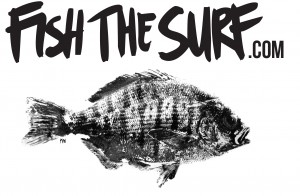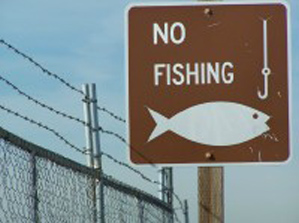(Where to Surf Fish? — Click Here MLPA Closure areas)
MLPA
(Marine Life Protection Act) and Surf Fishing
First, we must start by not losing hope that the closures will be permanent or that there is nothing you can do about them. I am dismayed by how many people I hear say they have accepted the closures and we should be happy with the areas that are still open. To that I say: HOG WASH!
How We Got Here:
My family has lived in Southern California since the 1800’s (That’s probably before we were even a state and the place was run by Spaniards!). That’s how long my family has been fishing here. My Dad frequently talks about fishing the Hermosa Pier in the 1930’s and how clear the water was. My Grandmother would ask my dad and uncle to go over to the pier and catch a halibut for dinner. They would go out to the end of the pier, look down, and because the water was so clear they could actually pick out the halibut to catch. They only had one problem: the albacore were so thick it was almost impossible to get your bait to the bottom!
So what has changed? Well, sure there are more fishermen but mostly there are less fish. And why is that? Why don’t albacore crash the local piers anymore?
Two Words: Water Quality
From 1892 until the completion of full secondary treatment on November 23, 1998 the Hyperion Plant located in El Segundo dumped billions of gallons of untreated raw sewage each year directly into the Santa Monica Bay.
Every time it rains millions of gallons of oil, radiator fluid, gasoline, trash and other carcinogens are washed off the streets from every county in Southern California and sent untreated into the ocean.
Every day the Orange County Sanitation District works to complete their secondary facilities but still dumps enough primary treated sewage into the ocean off Huntington Beach to fill an area the size of Newport Beach’s back bay.
These water quality issues and the removal of natural marine estuaries mean it’s not the big bad fisherman and his bucket. The fisherman didn’t create this problem. It’s a result of water pollution, urban sprawl, inept management, corruption and neglect that have put our ocean at risk.
Why is Water Quality Important?
In the 1930’s most of the Santa Monica Bay’s water was clear but as effluents from sewage and runoff filled the bay the water became turbid. Because of the lack of light reaching the bottom the basic building block of marine environments (simple marine algae) was unable to grow. As a result, there was less food for the smallest of marine creatures so they moved and died off. In return, the larger bait fish and other marine creatures died or left the area to find a new place to forage. Once the essential building block of the ocean was gone most of the fish left with it.
By allowing sewage (treated or not) and urban runoff to find its way to the ocean, turbid water rather than clear water, does not provide enough sunlight to sustain the fragile marine environment. Over fishing has very little to do with a lower biomass of marine creatures as does the toxic nature of the runoff. The biggest culprit by far has been the increased turbidity that does not allow light to penetrate the ocean in order to spawn basic algae–the essential building block of any marine environment.
In order to fight the closures we need three things:
#1. Everyone needs to know about the closures and why they are wrong. What does that means for you? Once you understand why the MLPA is wrong you need to tell your family and all your friends so they understand the issue too. One way to stay in touch with what’s happening is to visit the DFG website by where you will find updates and an overview of the MLPA. Here’s their link: http://www.dfg.ca.gov/mlpa/ Also, read the MLPA pages on my website. I’ve written them so they are easy to understand and follow.
#2. We all need to contact our State Representatives, Congressmen and Governor and let them know that the MLPA system has been implemented incorrectly and needs to be reviewed. To find out who your state politicians are and how to contact them visit: http://whoismyrepresentative.com/ and enter your zip code—it’s that easy!
#3. Donate time and money, to organizations like The Reef Project www.fishreefproject.net . A privately funded organization that produces environmentally safe reef pods and deploys them around the world. Rebuilding and introducing new reefs to the ocean bottom will provide ample places for fish to live and thrive.
Join CCA California who works to provide angler advocacy and represents you at the local, state and Federal level, provides hatchery programs, habitat restoration projects and introduces children to fishing. Find out more at: ccacalifornia.org
This is a battle not just for fishing rights but also for your right to enjoy the resources of your State for which we all have worked so hard to protect. Don’t let the government tell you where you can fish–Stand up for your rights and force them to do the right thing by preserving our oceans with fair and equitable management of the resource.
Next, What We All Must Do:
In order to improve the quality of our environment, our fishing and sustain this valuable resource we must:
1. Rescind this egregious Act
2. Establish a collective board of scientists to undertake a thorough baseline Marine Assessment Study of the entire State’s coastal fishery. This will create an inventory and determine the health of our marine environment. A baseline study provides a starting point so scientists can gauge the effectiveness of their management projects.
3. Enact legislation that enforces a clean water policy that returns only treated water from our sewers and streets to the ocean. For a healthy ocean water outflows must be both potable and non-turbid.
4. Establish and implement a fishery management program that provides for the building of artificial reefs, rigs to reef projects, stocking, sportsmen education and an oversight committee for the management of the State’s marine resource.
5. In light of the Marine Assessment Study, review current fish and game laws and implement slot limits, catch and release and reduced limits in those areas which are determined to have been impacted.
6. Continue to support and encourage the sanitation districts with their efforts to provide full treatment facilities for waste. So far they have taken giant steps to improve their facilities.
7. Encourage public and private groups to continue the restoration of marine estuaries and harbors, as these are the breeding grounds for tomorrow’s fish.
So there you have it! No political B.S. here, just the facts of what has happened and what we need to do to save the marine life along our coast and our right to fish there.
What’s seems most amazing is that all of this could be done with very few tax dollars. For years, the fishing industry has repeatedly proven they are glad to put some skin-in-the-game to get our marine resources managed correctly. Now it’s our time as individual fishermen to stand up for our rights and guide those who govern us into making the right choices we all need to save this valued resource.

